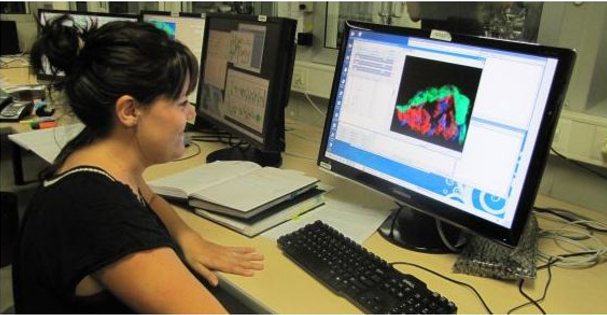- Home
- News
- General News
- X-rays reveal why...
X-rays reveal why Matisse's yellow loses its shine
03-07-2015
For more than a decade museum scientists have puzzled over the deterioration of a bright yellow pigment used in the paintings of impressionist, post-impressionist and early modernist painters including Matisse and Van Gogh. A new study using the ESRF's bright X-rays has revealed the chemistry of the discoloured paint and the chemistry used to prepare the paints that were available to the turn of the century's artists.
The European and American research team used the ESRF's ID21 beamline and a combination of methods such as X-ray diffraction, X-ray absorption spectroscopy, X-ray fluorescence analysis and infrared microscopy on tiny samples of damaged paint removed from masterpieces by Van Gogh, Matisse and James Ensor. The samples were as small as 1/100th of the thickness of a human hair.
The team found that the original chemical compound, cadmium sulphide, highly water insoluble and bright yellow, is subject to a light-induced oxidation process. This transforms it into a very water soluble cadmium sulphate, which is colourless.
“The main challenges associated with the analysis of such materials are the very limited amount of materials (far less than 1mm³) and their extreme complexity. This makes the use of synchrotron sub-micrometric probes essential”, says Marine Cotte, responsible for the ID21 beamline at the ESRF, where most of the experiments were carried out. Such micro-fragments, adds Marine Cotte, are usually made of various ingredients (the ones introduced by the painter, on purpose or unknowingly, and those related to degradation or to later conservation) and of various natures (from very well crystallised to amorphous compounds, from inorganic pigments to organic binders…) all associated in a complex micro-stratigraphy. The ID21 beamline provides many analytical techniques (based on X-‐ray and infrared light) but the application of such beams to such samples is not straightforward.
The results permit preventive conservation measures such as closer management of in-museum light and relative humidity levels to be implemented, aimed at slowing down or even stopping the naturally occuring but undesired chemical transformations.
The research team was headed by Dr. Jennifer Mass, Senior Scientist at the Scientific Research and Analysis Laboratory of the Winterthur Museum (Delaware, USA) and associate professor at the Programme on Art Conservation of the University of Delaware. The team also comprised scientists from the Universities of Antwerp (Belgium), Utrecht (Netherlands), Washington and Lee University (USA) as well as from the ‘Commissariat à l’énergie atomique et aux énergies alternatives’ (CEA, France) and two synchrotron radiation facilities, the European Synchrotron (ESRF, Grenoble, France) and Stanford Synchrotron Laboratory (SSRL, CA, USA). Funding for the research was provided in part by the Mellon Foundation and the Lenfest Foundation through grants to the Barnes Foundation, Philadelphia, PA.
In parallel a PhD thesis, led by Emeline Pouyet of the ESRF, was dedicated to the optimisation of all steps of the experiment, from the implementation of strategies for sample preparation, to the full data analysis, integrating results from all experiments (elemental, molecular and structural composition).

Emeline Pouyet, at the ESRF's ID21 beamline. Credit: Marie Lyan
Link to the publication J. Mass et al.
Link to the publication E. Pouyet et al.
See the full press release (pdf)
Top image: Henri Matisse, The Joy of Life, 1905-06. Credit: The Barnes Foundation



